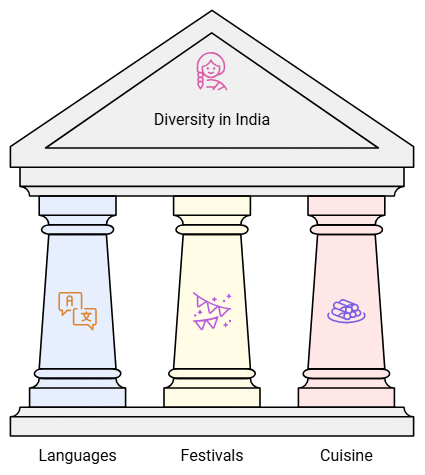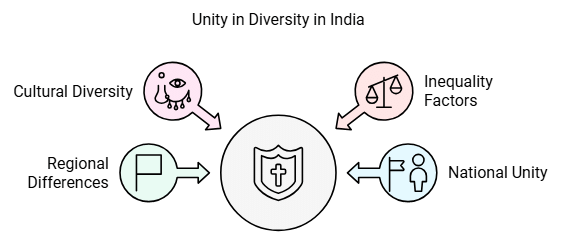Class 6 Civics Chapter 1 Notes - Diversity
Diversity in India: India is a country of vast diversity. People speak different languages, celebrate different festivals and eat various types of food. Diversity is a reality created by individuals and groups from a broad spectrum of demographic and philosophical differences.

Factors Influencing Diversity: Historical and geographical factors are the two factors that influence the diversity of a region. Life of people near the sea is different from the people in a mountainous area.
Ladakh: Ladakh is a land with awesome physical features and is set in an enormous and spectacular environment. It is surrounded by the world’s mightiest mountain ranges, the Karakoram in the North and the Great Himalayas in the South.
Kerala: Kerala is located in the South-Western part of India. It is surrounded by sea on one side and hills on the other.
Unity in Diversity: India is a land of different religions and communities. There is a great diversity in our habits and customs and yet we all live together as Indians. “Unity in Diversity” has been the distinctive feature of our country.
- Everyone on earth differs from each other with respect to aspects like looks, behaviour, culture, religion, language, talent etc. This means that there is diversity among people in these aspects. Diversity means the lack of uniformity and the sense of variety.
- Inequality comes about among people when they have different access to resources and opportunities. The caste system, religion, financial well-being, education, etc. are various forms of inequality in the society.
- India is a country of several diversities. Since it is a very big country, people in different parts differ in their customs, language, habits, etc. These diversities arise from the fact that different regions have different histories and environments.
- Despite the diversities listed above, there are similarities that unite us. We all are Indian and during the freedom struggle, the whole country came together to send away the British, Irrespective of their diverse backgrounds. The Indian national flag is the most important national symbol and it reminds us of our unity in diversity.

Diversity: The sense of variety that exists in the traits, looks, behaviour, culture, religion, language, abilities, resources and opportunities related to different people is said to be diversity.
Inequality: The differences between two or more people that arise because of their abilities, resources and opportunities, or their caste, etc. are termed as inequalities.
Habitat: The geographical area where a living being has adapted and lives comfortably is called the habitat of that living being.
Resources: Anything that can be of any use in any activity is said to be a resource.
The Jallianwalla Bagh Massacre: On April 13, 1919, a British general and his troops attacked a large meeting of unarmed people. Several men and women were killed brutally. This incident is called the Jallianwalla Bagh massacre after the name of the meeting place in Amritsar, Punjab.
This anecdote is from Poile Sengupta’s ‘The Lights Changed. Samir befriends a small ragged newspaper boy while waiting for the traffic light to turn green. The friendship develops slowly over a period of a few days. It shows that friendship can develop between two very different persons as well. Coincidentally, the newsboy’s name was also Samir.
But he happened to be ‘a Muslim Samir’. The two Samirs came from different religions. Moreover, they have different opportunities. While one went to school, the other could not.
|
297 videos|1066 docs|204 tests
|
FAQs on Class 6 Civics Chapter 1 Notes - Diversity
| 1. What is meant by diversity in society? |  |
| 2. Why is understanding diversity important in today's world? |  |
| 3. How can individuals promote diversity in their communities? |  |
| 4. What are some common challenges related to diversity? |  |
| 5. How does diversity benefit organizations and workplaces? |  |
















